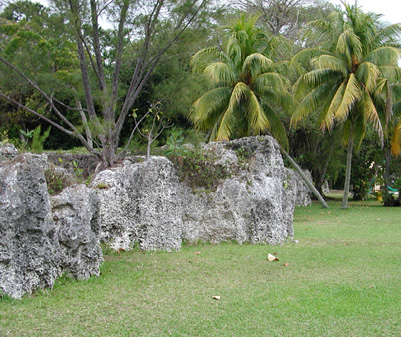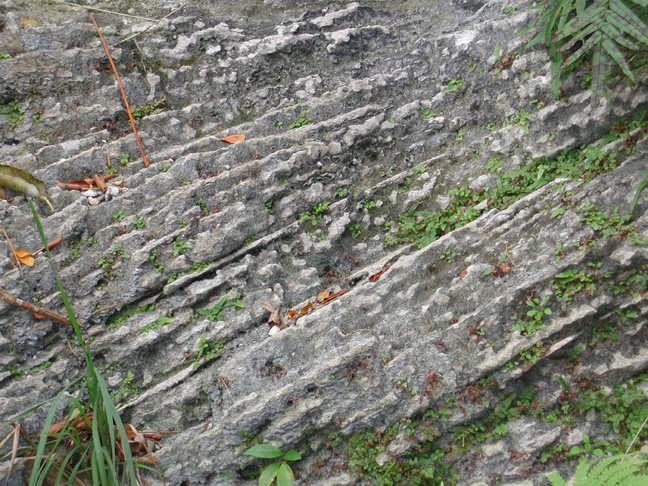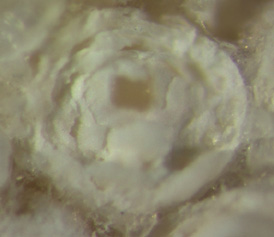Virtual Field Trip of Selected Exposures of the Miami Limestone
Miami-Dade & Broward counties, Florida
The Miami Limestone, formerly known as the Miami Oolite (Sanford 1909), is one of three distinct Pleistocene rock formations in southeastern Florida. The formation was deposited during the Sangamon interglacial and Wisconsin glacial stages as a narrow band of oolitic carbonate in a north-south trending barrier bar system along the eastern portion of present day Miami-Dade and Broward counties. Osmond, Carpenter, and Windom (1965) and Broecker and Thurber (1965) through uranium-series dating concluded that the Miami Limestone is about 130,000 years old. Sub-aerial exposure of the deposits occurred during the lowering of sea level during the Wisconsian. Rainwater at this time flowed through the pore spaces allowing calcite to precipitate around the grains and formed the indurated rock (Halley and Evans).
The cross-bedding throughout the formation is differentially weathered. Differential weathering, or selective cementation, is visible in 2 cm couplets, with the well-cemented layers being more resistant.
The limestone is composed mainly of ooids with some quartz sand and small mollusk fossils ( Figure 1 ). The Miami Limestone ooids are small coated carbonate grains, which contain a nucleus of either a shell fragment or a quartz grain (Figure 2). These small round spheres were formed by the deposition of one to five concentric layers of aragonite. Most of the aragonite has now been converted into calcite (Halley and Evans, 1983). The Miami Limestone can be classified as oosparitic, or oolitic grainstone, since it is grain supported, and lacks lime mud.
The stops for this field trip ranged from south Miami-Dade County to the most northerly exposure in central Broward County. Several locations such as Alice Wainwright Park, Coral Way, and numerous outcrops along Bayshore Drive are low-lying bluffs, with Silver Bluff being a wave-cut cliff or bench.
The Miami Limestone is one of three contemporaneous deposits in South Florida; with the Anastasia Formation to the north, and the Key Largo Limestone to the south.
A similar active ooid shoal environment now exists in the Bahamas (Hoffmeister, Stockman, and Multer, 1967).
Localities
References
Cooke, C.W. 1945, Geology of Florida; Florida Geological Survey Bulletin No. 29, p. 249-262
Halley, Robert B. and Charles C. Evans, 1983, The Miami Limestone, A Guide to Selected Outcrops and Their Interpretation, Miami Geological Society
Hoffmeister, J.E., 1974, Land From the Sea, University of Miami Press, Coral Gables, Florida
Hoffmeister, J.E., K.W. Stockman, and H.G. Multer, 1967, Miami Limestone of Florida, and it's recent Bahamian Counterpart: Geological Society of America, v. 78, p. 175-190
Osmond, J.K., J.R. Carpenter, and H.L. Windom, 1965, 230Th/234U age of the Pleistocene corals and oolites of Florida: Journal Geophys. Res., v. 70
Puri, H. S., and R.O. Vernon, 1964, Summary of the geology of Florida and a guidebook to the classic exposures: Florida Geological Survey Special Bulletin No. 5
Puri, Harbans S., and George O. Winston, 1974, Geologic Framework of the High Transmissivity Zones in South Florida: Florida Geological Survey Special Bulletin No. 20
Randazzo, Anthony F., and Douglas S. Jones, 1997, The Geology of Florida, University of Florida Press, Gainesville, Florida
Shinn, E.A., 1968, Burrowing in recent lime sediments of Florida and the Bahamas; Journal Paleontology, v. 42, p. 879-894
Acknowledgments
This website was created under the tutelage of Dr. Anton Oleinik.
All microscope photos: Anton Oleinik.
Questions or comments? E-mail: geologist@bellsouth.net





